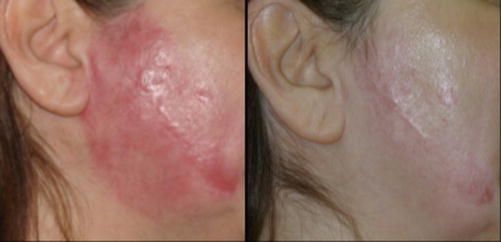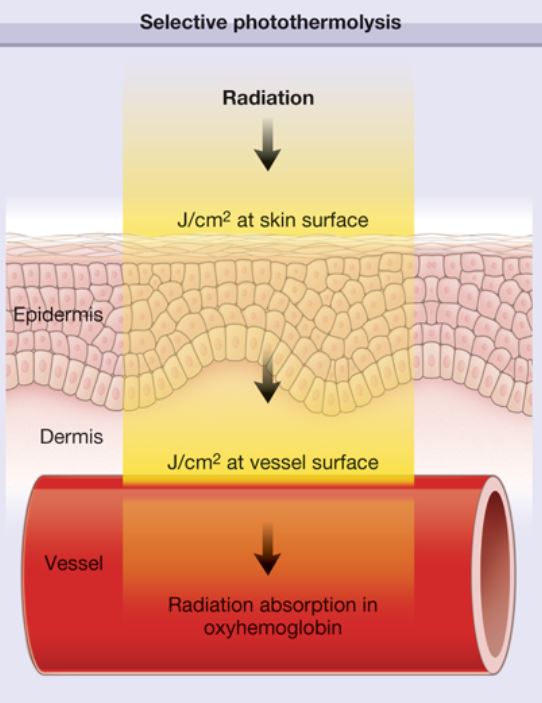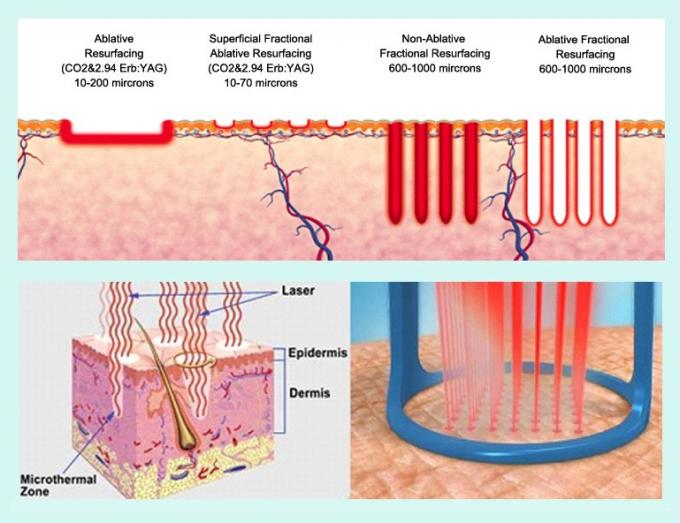Laser based therapy of scars and wounds is a relatively new technology treatment that started in the 1980s. At first, CO2 and argon lasers were used to vaporize scar tissue and lessen the texture of the affected area. Diode based systems were also introduced around the same time. These actually helped relieve the physiological symptoms of scars that would cause pain and irritation to the patients. Then in the 1990s, pulsed dye lasers (PDLs) were developed to work inside the microvasculature of scars. This laser scar treatment would target and destroy certain blood vessels within the scar tissue and cause photochemical cascades that would improve the smoothness and swelling of the tissues.
In the next decade, pulsed dye lasers were improved upon and long pulsed dye lasers (LPDLs) were trialed on scars. Two different methods were used with LPDLs: ablative and non-ablative. Ablative methods had the advantage of more aggressively tackling swollen and raised keloids with higher energy lasers. On the other hand, non-ablative methods used lower wavelength lasers that allowed more miniscule and fine-tuned treatment of small lines and hole texture. Since then many more techniques have been developed, although there currently does not exist much regulation over laser scar treatments. In this article we will discuss the principles of laser scar treatment and a popular laser scar treatment technique in usage today.
Principle of Laser Scar Treatment
During a successful wound healing process, cells and chemical reactions work together to repair damaged tissue. The most important part in this process is the balance of collagen production and degradation. If there is an excess amount of collagen produced, a raised keloid or scar will form. Often, the affected area is obvious, discolored, and may burn or itch. The treatment of scars is difficult because they may grow larger in certain areas of the body that receive a lot of friction, and there is no standard cure for such a varied range of wounds. Currently, laser treatments are the most advanced and noninvasive methods we have for treatment of scars.
Plan of Attack
The most important steps of laser scar treatment are evaluation of the type of scar and the treatment plan. Each scar and patient’s skin type is unique, so the characteristics of both should be duly noted in order to develop the best plan of attack. For example, the color is usually the first step of treatment (can be done by topical creams), and the configuration of the scar comes second. This is where lasers come in. How laser treatment really works is by stimulating the outer layers of scar tissue to promote new and healthy cell growth. In some cases, the scar may not be able to be erased completely, but can be adjusted to become much less noticeable and more uniform.

Before and after of nonablative laser scar treatment. Significant physical improvement can be noted in redness and texture. Courtesy of Anderson R et al.
Another important step in laser scar treatment is choosing the right laser wavelength. In the principle of ‘selective photothermolysis’, everyone’s skin structure responds to different wavelengths. This is due to the chromophores contained in skin tissue that gives it its color. In other words, chromophores absorb and reflect certain wavelengths of light. Thus, a laser incident on the chromophores will only be able to affect them if the wavelengths match. This is also why lasers are so good for scar treatment. Laser beams can selectively destroy small targeted structures in skin through selective photothermolysis. Healthy tissues can be left alone, and treatment can be individualized for each unique section of the scar.

Diagram of selective photothermolysis and depth penetration onto a blood vessel under skin surface. Courtesy of Goldsmith et al.
Current Market Techniques:
Current laser scar treatment techniques fall into two categories: ablative and non-ablative. Ablative measures physically remove some part of the scar tissue to flatten and improve the texture of the scar. They work by vaporizing the water inside scar tissue cells, and causing them to die and slough off. Some common ablative laser techniques utilize fractional carbon dioxide lasers, 980-nm diode lasers, and long pulsed 1064-nm Nd:YG lasers. Alternatively, we have non-ablative techniques which rearrange the structures in scar tissues without removing them. Today we will discuss non-ablative fractional lasers for scar treatment.
Nonablative Fractional Laser (NAFL) Technique
Nonablative fractional laser treatments utilize ‘fractional photothermolysis’ to induce necrosis of targeted structures, such as melanin pigments, in scars. Additionally, the name comes from how these treatments target only a fraction of the skin surface. Usually, these lasers only irradiate up to 5-10% of the skin surface for gentle scar therapy. The treatment is gentle because surrounding areas of the treatment zone have reversible damage, while the treated area dies and surrounding tissue quickly regenerates.
Additionally, fractional non-ablative lasers are used in groups of up to 400 small beams in the 50-100 micrometer range, and on square centimeters of skin at a time. While fractional lasers provide great surface area precision , their penetration depth can also be fine tuned. Namely, the strength of the laser beam controls the depth. For instance, weaker settings (mJ range) allow for more shallow depths and vise versa. Most often, nonablative fractional lasers work on the upper dermis layer which is at 400 μm skin depth.
How it Works in an Office
To illustrate how this treatment would work at an office, the doctor would move the hand piece in stamp mode which treats a small “stamped” area (a.k.a MTZ zone). The laser can be operated in dynamic mode where the laser irradiates continuously. Each targeted scar area can be treated multiple times, and larger surface areas can be treated with a larger number of laser beams. This can be done with a change of instruments or settings. Some important things to note are that nonablative fractional laser treatment side effects include erythema and edemas. However, these symptoms subside within hours and makeup can be applied within hours of treatment. Nonablative laser scar treatments have the advantage of less recovery and down-time than their ablative counterparts, which may take months to recover from.

Diagram showing ablative and non-ablative fractional laser treatment of stamped scar areas, illustrating skin layers and depth penetration. Courtesy of Kes.
Conclusion
Laser scar treatment umbrellas many different laser systems that allow proper wound healing and symptom management. These techniques are best used when individualized and evaluated for each unique scar. Scars are very fickle and notoriously tough to work with depending on the patient’s skin type and genes. However, lasers allow precise treatment on the micro-level in the tissue so that each treatment can be fine tuned for each area of scarring. The market value of laser scar treatment is projected to grow to 15 billion USD by 2022. Newer and better laser technologies are continually being researched and trialed. As the biomechanisms and interactions of photochemical cascades continue to become more clear in modern day labs, we can predict much more advanced scar removal and wound healing results in the future. Severe and painful scars may become easy to treat, just like in science fiction media.
This post is sponsored by Gentec-EO – Leader in Laser Beam Measurements

It was really informative when you explained that lasers are the most advanced method of treating scars. I have a fairly large scar above my eye, and it makes me feel less confident in myself from time to time. It might be a good idea for me to see if I can find a service that can remove the scar.